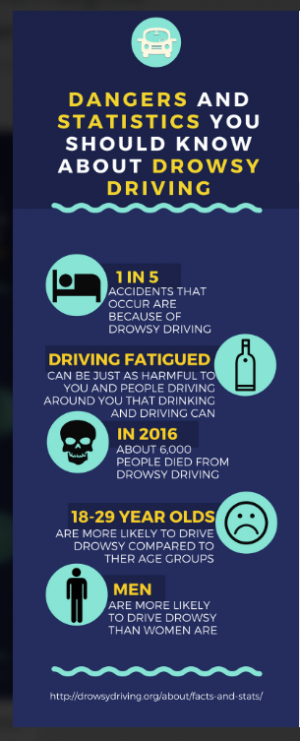Hours passed and no one was picking up the phone. Junior Stephanie Lewis and her mom call about every 15 minutes praying that her dad would answer. After about three phone calls, they start to worry. At last, they find out why.
Lewis’ dad was in a life-threatening car accident as a cause of drowsy driving. Since his first accident, he has been in three others because of fatigue behind the wheel. Approximately 21 percent of all crashes are caused by drowsy driving. Lewis recalls the time her dad was affected by this statistic.
“I was terrified and worried sick,” Lewis said. “I remember it was past the usual time he got home, and he just didn’t show up. My mom said he was probably stuck in traffic, but it turned out to be the wreck.”
Drowsy driving can be described as the operation of a motor vehicle while being impaired by a lack of sleep. This impairment while driving continuously grows over time. To this day, there are no ways to test if the operator of a vehicle was sleepy while behind the wheel.
People understand the harmful effects linked to drinking and driving but do not realize that driving while they’re tired can be just as fatal. One in five accidents are because drivers did not get enough sleep the night before.
“My dad has had sleep apnea my whole life, but I never knew what it was,” Lewis said. “[Sleep apnea] constantly woke him up, so he never got real sleep which was why he was falling asleep behind the wheel.”
Sleep apnea affects the function of your breath to the point of shallowing or stopping during sleep. This occurs whenever the muscles in the back of your throat relax. When these muscles relax, your airway narrows as you breathe in, preventing an adequate breath. People with sleep apnea may make a snorting or snoring sound while they sleep. Many people with this disorder think they’re getting a good night’s rest, but in reality, the oxygen level in their blood decreases without them even knowing.
“After my dad totaled his third car, he realized he had a problem and went in for a sleep study,” Lewis said. “He has a breathing machine that helps him sleep through the whole night now.”
The Dangers of Drowsy Driving
Most people are knowledgeable about the dangers of driving under the influence but don’t realize that drowsy driving can be just as bad, if not worse. Drowsy driving has the same likelihood to cause accidents as a few drinks of alcohol. However, one major difference between the two remains: there are no breath, blood or other tests for being tired behind the wheel.
“I definitely think drowsy driving is just as bad as drinking or texting,” Lewis said. “In all of those scenarios, the driver isn’t conscious or aware of their surroundings to keep themselves and other drivers safe. Their minds are in a different place.”
There’s no way to accurately test if a driver was impaired by sleepiness. It can hard for police to identify the reason for the crash. In the case of a fatality, it would be hard for the family to get closure if they don’t know the full story of what happened. Lewis’ dad was fortunate enough to be able to walk away from the scene and let his family know what happened.
“He finally called to tell us he was in an accident,” Lewis said. “Luckily most of the damage was on the car.”
In 2005, the National Sleep Foundation ran a poll to see how many Americans admitted to drowsy driving. Sixty percent of adult drivers said they have driven a vehicle while being fatigued and more than one-third of them have fallen asleep behind the wheel. Junior Sarah McQuaid was in an accident due to lack of sleep earlier this school year.
“I was driving on a backroad to school, and I had to scoot over for oncoming traffic,” McQuaid said. “I wasn’t aware I moved over too far then I hit a cement block.”
In addition to the lack of testing for drowsy driving, there are many other effects that sleepiness behind the wheel can cause such as impaired reaction time, problems with information processing and short-term memory, decreased performance and increased moodiness or aggressive behaviors. The driver may become irritable and start to speed to get to their location faster. Speeding can then lead to getting a ticket or worse, a crash. McQuaid is one example of how fast an accident can happen because of driving while impaired in any way.
“Drowsy driving is a problem because drowsy drivers are just as bad as drunk drivers,” McQuaid. “Their reaction times are slower and they’re less aware of our surroundings.” 
Adults between 18-29 prove to be more likely to drive drowsy compared to other age groups. Reasons for this being may be that they are still young, they struggle to balance their schedules and may not have figured out the best way to manage their time. While young adults are at the highest risk, men have a bigger tendency to drive while fatigued than women.
“[Young adults] drive while fatigued because we have to,” McQuaid said. “Teens have to wake up before the sun is even out just to get to school, then go to after school activities, sports of jobs, and after that we come home to do homework for two hours. We go to bed late and wake up early to start the day over again running on barely any sleep.”
Drowsy driving claimed 856 lives in 2014, an estimated 5,000 in 2015 and 6,000 in 2016. Thankfully, McQuaid’s accident wasn’t as bad as it could’ve been. She ended up on a concrete drain support on the side of the road. Her truck’s front tire axle and frame were bent, the passenger side mirror was smashed and a headlight popped out.
“My accident wasn’t too bad,” McQuaid said. “My physical injuries were a concussion and minor strains in my shoulder and knee from slamming into my door during the impact. I learned that I shouldn’t drive while tired.”
Take it From a Pro
Mr. John Sudbury, a chemistry teacher at Legacy, has a part time job as a driving instructor at the Mansfield Driving Academy. Mr. Sudbury teaches kids about the dangers of distracted driving and the harm it can cause to yourself and others around you.
“We cover drugs and alcohol and how it affects the driving process,” Mr. Sudbury said. “We also cover other forms of distracted or inattentive driving, which includes using your phone while driving, being distracted by people or objects in the car with you, and making sure you do not drive without proper rest when you are sleepy or fatigued.”
Many people assume driving while tired can only happen in the evening or late at night. However, being tired or fatigued early in the morning when driving to school can be just as dangerous to yourself and others around you. When tired you are more likely to not be fully alert, have delayed reaction/response time, and experience impaired judgment while driving. Drowsy drivers don’t scan the upcoming roadway efficiently and are hazardous to themselves and others around them.
“Thankfully, I have never lost a student [from Legacy or the Driving academy] due to a car accident while they were a student of mine.” Mr. Sudbury said. “I am sure many students and adults drive when they are too tired to fully give their attention to the driving task”
Do’s and Don’ts
Don’t drive if you are on medication that makes you drowsy or not fully alert to your surroundings.
Do drive if you have received a full night’s rest. (8-10 hours)
Don’t rely on the radio, caffeine, chewing gum or opening the window to keep you awake.
Do pull over if you find yourself falling asleep behind the wheel.
Don’t drive at times when you would normally be sleeping.
Do drive with a friend. A passenger that stays alert and keeps you in conversation will help stimulate your brain and will keep you awake.
Know Yourself
Know yourself well enough to determine if you are too sleepy to drive or not. Every time you get in your car, you put yourself and everyone else driving around you at risk if you are not fully engaged at getting to your destination. Look for warning signs like frequent blinking, missing your exit or drifting into the lane next to you.
Don’t be the reason someone loses their life.




